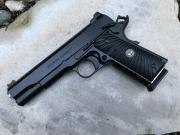I am new to 1911s having recently acquired a Dan Wesson Specialist in 10mm. I am trying to learn all the aspects of the platform design and operation. It seems that when the slide is returning to battery (after firing and cocking the hammer) the leading edge of the bar that cocks the hammer, moves forward to strip a round from magazine and push it into the chamber. That same bar actuates the disconnector vertically with a milled groove in the rear of the bar. When I am charging my pistol from “slide lock” position (using the slide release) there is a “bump” when the leading edge of that bar hits the disconnector. The recoil spring provides enough force to overcome that resistance and function properly. I saw a Utube video where a gunsmith milled a tapered ramp on the leading edge of that bar on the center section that would hit the disconnector but left the outer edges 90 degrees to ensure proper round stripping. That looks like a nice modification. I am not going to do that to my 1911. But I noticed on the rear of that same bar , the firing pin stop that strikes the hammer, that edge has a radius on it to reduce the hammer resistance when cocking. If I was a gunsmith I think I would put a ramp on that edge that strikes the disconnector which would make the slide operation smoother and seems it could only make the chambering function more reliable. Any thoughts? And is there a name for “that bar” I keep referring to that cocks the hammer and actuates the disconnector? Thanks in advance



 Reply With Quote
Reply With Quote



